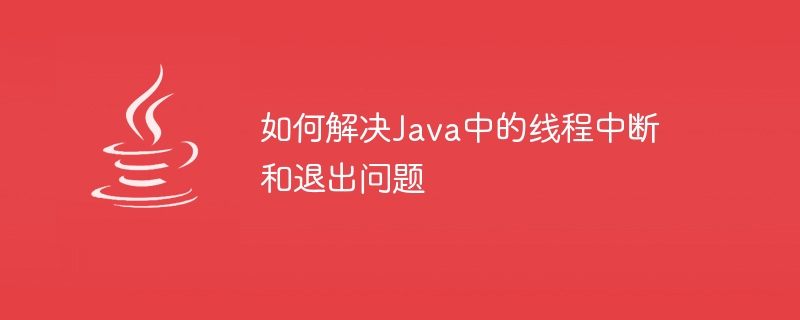

How to solve the problem of thread interruption and exit in Java
In Java development, threads are one of the commonly used concurrent programming methods. However, handling thread interruption and exit issues is an important skill. This article will introduce how to correctly solve thread interruption and exit problems in Java and provide specific code examples.
To demonstrate this problem, we assume that there is a thread T1 that performs a time-consuming task. We want to be able to correctly interrupt and stop the execution of the T1 thread in the main thread.
Solution
In Java, the interrupt operation is implemented by calling the interrupt() method of the thread. When this method is called, thread T1 will receive an interrupt signal. However, the thread does not stop execution immediately but continues running.
In order to correctly handle thread interrupts, we can use the following two-step strategy:
if(Thread.currentThread().isInterrupted()){
throw new InterruptedException();
}This code will detect the interruption status of the current thread and throw an InterruptedException exception. By catching this exception, you give the thread a chance to exit the task.
In addition, if the time-consuming task is a blocking operation (such as waiting for a response from an external resource), you can use interruptible blocking methods, such as Thread.sleep() and Object.wait(). These methods will immediately throw InterruptedException when interrupted. We only need to exit after catching the exception.
The following is a complete sample code:
public class InterruptExample {
public static void main(String[] args) throws InterruptedException {
Thread t1 = new Thread(new Worker());
t1.start();
// 休眠3秒,等待t1线程执行
Thread.sleep(3000);
// 中断线程t1
t1.interrupt();
}
public static class Worker implements Runnable {
public void run() {
try {
while (true) {
// 假设这里是一个耗时的任务
if (Thread.currentThread().isInterrupted()) {
throw new InterruptedException();
}
System.out.println("Running...");
}
} catch (InterruptedException e) {
System.out.println("Caught InterruptedException, exiting...");
}
}
}
}In the above code, we create a Worker thread and start it in the main thread. After the main thread sleeps for 3 seconds, call t1.interrupt() to interrupt the execution of the Worker thread.
In the run() method of the Worker thread, we use the isInterrupted() method to detect the interruption status and throw an InterruptedException when exiting.
Summary
Correctly handling thread interruption and exit issues in Java is an important skill in concurrent programming. Detecting interrupt signals in time-consuming tasks and using interruptible blocking methods can allow the thread to exit in time. Sending an interrupt signal in the main thread can send an interrupt signal to the working thread to improve the controllability of the program.
I hope the solutions and code examples in this article can help you correctly handle thread interruption and exit problems in Java.
The above is the detailed content of How to solve thread interruption and exit problems in Java. For more information, please follow other related articles on the PHP Chinese website!
